
As a qualified teacher, mum, parenting coach and all-round Early Years expert, Sophie has a wealth of practical, real life experience to share with parents.

As a mum of two and a registered GP, Stephanie has seen more than her fair share of little ones! She has lots of practical tips and professional know-how on hand to help parents.

Laura is our nutrition whizz – bringing her expert advice and experience from working with chefs, schools and nurseries to the Kiddylicious expert panel.


Laura:
Okay, let’s get started. One of the first things to remind parents is that, after a lunch or dinner where kids haven’t eaten much, the next meal or snack time is only a couple of hours away. There’s always another food opportunity coming up, so try not to stress if they don’t eat. Just make it quite clear to your child that you’ve finished that mealtime and that snack time is in a couple of hours, so they will have some more food then.
Stephanie:
I remember when I was going through fussy stages with my eldest, someone said to me, try not to focus on what they’ve had that day, sit back and think about what they have eaten over the course of the week. That’s so reassuring.
Sophie:
Yes, don’t just look at the meal, look at the day and the week. You can think to yourself, they haven’t eaten much dinner but they had a big lunch. I think it’s important to encourage them to self-regulate as well. Avoid saying things like: “clear your plate” and “that’s not good enough, eat some more.”
Laura:
You can also teach them signs for ‘meal finished,’ ‘full tummy,’ using the same words each day, so they can get to grips with it and repeat it back to you.
Sophie:
Baby sign language is such a useful tool and you can start from birth. You wouldn’t expect them to start signing back to you until they reach around 10 months but it can be great to do it around mealtimes. And if they’re too little to sign or speak, they can show they’re full in other ways, it can be that they turn their head away or hold up their hand. Listening to and watching for those cues is so key.
Laura:
I get asked a lot about what portion size parents should offer their children but I try not to talk about this, because parents can get a bit hung up on it. Babies and children have got the best inbuilt system in them and they will tell you when they’ve had enough. Be sure that you’re reading those signs.
Sophie:
Don’t get hung up on portion size – if you have put a certain amount in a bowl, don’t think that means they’ve got to clear it. If they’re saying no, you need to be able to take a step away.
Think about not overloading their plate. When they reach that fussier phase, around two and a half, they may push the plate away before they’ve even started. It’s not necessarily because they don’t want to eat it, it’s because it’s overwhelming. If you pare it right back to giving less than you think they will eat and put one piece of each food on the plate at a time, they can then ask for more, which gives independence and that feeling of being in control of the situation.
Laura:
Family-style mealtime approaches (where the food is placed in the middle of the table to be dished up) can be quite useful from a young age, encouraging them to help themselves, so that they can regulate their food intake. When babies are going through growth spurts, they can eat an inordinate amount of food and they will potentially eat the same amount as you would in a sitting. There’s nothing wrong with that, they won’t overeat. There’s also a worry that if babies are on a high percentile, their parents worry about feeding them too much when that’s not necessarily true.
Stephanie:
My daughter is on a low percentile – she always has been and that was a source of real stress. When we’re at play groups I get the comments: “Oh, she’s so tiny,” and for me, that translated to: “you’re not feeding her enough.” It took me a long time to be able to see past that and think, that’s just her build. We come in all shapes and sizes. Her appetite is not bad, and I don’t need to push her to eat more, that’s just her frame. I have friends who had taller, bigger babies, and they sometimes wouldn’t eat as much.
Sophie:
One of my sons is on the ninth percentile and has always been and my other is on the 98th. So they’re completely different, but they eat the same. And it’s good to remember when they’re little, as long as they are having their milk, you don’t really need to worry about how much food they eat.
Stephanie:
If your baby is not gaining weight though, flag it up when you see your health visitor or GP. If they are growing properly, don’t worry too much in terms of the volume they eat.


Stephanie:
There’s no such thing as a perfect mealtime. I think it’s so important to talk about the realities of mealtimes, even if your child ate everything. There’s mess, there’s chaos, if you’ve got two kids, you have to go back and forth with them. Those adverts that show a family sitting around a pristine table – that is rarely the case!
Sophie:
It’s worth touching on social media, because although it can be great, it can also be a negative for parents. It can create an image in your mind of what your mealtime should look like. I can testify to the fact that a lot of the things that you see on social media are not real! They set up situations and they take a photo, their child may not even be there. You can spend all this time setting up nice play activities or creating a beautiful meal with different shaped food cutters, and then they won’t eat it, or they won’t play with it!
Stephanie:
Social media is an aesthetic place, isn’t it? People want to make things look pretty and whilst you’re right, it can certainly provide some inspiration. I think the reality is, a lot of dinner plates do not look like that! Even a balanced meal can look unattractive. As long as they are fed and they’re happy then they don’t actually care what it looks like. Sometimes, the days where you just open the fridge and grab whatever there is and throw it together can be the best meals. Take a step back and look at it through their eyes – they don’t care and they’re not judging you!